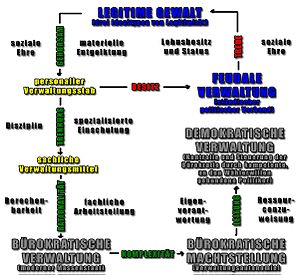Parliament and government in reorganized Germany
The work Parliament and Government in the reorganized Germany , created during the First World War . On the political criticism of the civil service and party system by Max Weber is one of his most important writings on administration and politics with a focus on bureaucratization .
Requirements for Max Weber's considerations on administration
- Parliamentarism as a superior and desirable form of government (state form here in today hardly common sense of form of government ) for Germany (Weber particular the British Parliament as a model in mind)
- Demand for equal suffrage and democracy (the duty of those "who stayed at home" to the fighters at the front to reform the political system)
- Determining the form of government must be viewed as a purely pragmatic (“appropriate state-technical”) question of the organization and institutionalization of politics
Politics and administration
- “ In a modern state, the real rule, which […] has an effect in the handling of the administration in everyday life, necessarily and inevitably lies in the hands of the civil servants. "(" Universal bureaucratization ")
- Compulsion to bureaucratisation through the formation of special purpose associations of people, both in business, religion, military and of course in politics and administration (specialization and division of labor to reduce complexity in modern mass societies)
- Separation of administrative resources (resources in the economy) and administrative staff (workers in capitalism) leads to bureaucratisation ("rational organization of work on the basis of rational technology")
- The predictability of the administration (calculability in the economy, see also legal certainty ) and corresponding management and control options for politics are of decisive importance
- clear distinction between political or economic leadership or "positive politics" (with own decision-making responsibility) and bureaucratic administration or "negative politics" (only mandatory execution)
Features of modern administration / bureaucracy
- rational professional specialization and training of civil servants (specialist civil servants)
- Inescapability and permanence of bureaucracy ("inevitable power")
- increasing autonomy of the bureaucracy from the ruling power through the enormous complexity of mass societies and the specialization of the civil service
- “ An orderly spirit is also the living machine that the bureaucratic organization represents with its specialization of trained specialist work, its delimitation of competencies, its regulations and hierarchically graded obedience relationships. "
Danger from modern administration / bureaucracy
- Warning against the (socialist) connection between private (economy) and public (state) bureaucracy, as it cannot be fought because of its inescapability and because of its unlimited validity it does not allow competition
- Risk to liberal individual rights (human rights) and democracy (political control and control of the administration) through increasing autonomy of the administration
Three dimensions and institutions of domination
- Monarchy: mixture of symbol and executive with representational functions (Weber remains unclear here because of his rather Caesarist adherence to the monarchy )
- Parliament: Legislative and executive branches recruiting from it with genuine political leadership and control functions (budget law)
- Bureaucracy: State administration with an executive function and rational technical specialization to reduce complexity
See also
literature
- Parliament and government in reorganized Germany. On the political criticism of the civil service and party system , Duncker & Humblot , Munich, Leipzig 1918. online
- Parliament and government in reorganized Germany. On the political criticism of the civil service and party system , in: Collected political writings , ed. by Johannes Winckelmann , 5th ed. 1988, pp. 306 to 443. ISBN 3-8252-1491-5
